South Pole
The South Pole is found where the Earth's axis of rotation intersects the surface in the Southern hemisphere, in the remote, bleak interior of Antarctica. The U.S. has maintained the Amundsen-Scott South Pole Station at the South Pole since 1956. The station lies a few hundred meters from the actual Pole, which constantly moves relative to the station because of the constant drifting of the ice beneath it.
Understand
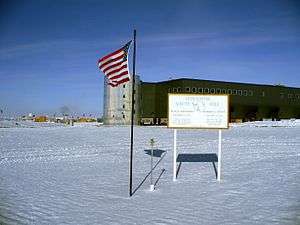
Although there's more than one definition of "the South Pole", the most popularly accepted one (and a travel destination) is a fixed location in the southern hemisphere at the Earth's axis of rotation, latitude 90°S (longitude not applicable). The Earth's axis, and therefore the position of the South Pole, is constantly subject to wobbles of up to several meters known as polar motion. However, the "South Pole" — that is, the one defined as 90°S — remains in a fixed position for practical reasons, like keeping coordinates steady, with polar motion and the precise definition of the South Pole only relevant for certain scientific activities. Unlike the North Pole, which is nothing but possibly a sheet of ice floating on the surface of the Arctic Ocean, the geographic South Pole is on solid ground, allowing a permanent research station to be built at the site of the pole itself. Although it was once an elusive goal that took the lives of many explorers, thanks to modern technology, it has been permanently staffed since 1956. The overwhelming majority of the South Pole's visitors are scientists and support staff for the U.S. Antarctic Program and the Antarctic research arms of other nations visiting the station. The station can also now be reached by commercial travel expeditions, although the high cost (from US$45,000) keeps private visitor numbers very low. The actual pole is marked by a metal rod, adjusted on New Year's Day each year to account for the movement of the ice around the site.
The "South Pole" is also defined magnetically, where all field lines of the Earth's magnetic field point upwards, which continues to be important for navigational purposes. The South Magnetic Pole drifts around, located in the Southern Ocean at 64°16′48″S, 136°35′24″E in 2015 and moving by about 10–15 km per year. Since there's nothing particularly interesting about it other than perhaps watching your compass not work, it receives no visitors. It is not to be confused with the confusingly similar South Geomagnetic Pole, at 79.74°S 108.22°E near Vostok Station in 2005 and wobbling slightly over time. The Earth's magnetic field can be likened to a strong bar magnet, with two polar opposites. The South Geomagnetic Pole lies where a line of best fit for this field, drawn through the Earth's center, intersects the surface in the Southern hemisphere – forcing it into an exactly-antipodal position with the North Geomagnetic Pole. The South Magnetic Pole is where the actual field lines come together since the field is not perfectly symmetrical and does not conform to a straight axis. Geologic evidence has shown that the Earth's magnetic field has been subject to reversals on average about once every 500,000 years, suggesting that the North and South magnetic poles are likely to swap spots at some unknown point in the future.
Of interest to explorers and adventurers is the pole of inaccessibility marking the furthest point on a continent or ocean from any coastline. The Southern Pole of Inaccessibility is the furthest point in Antarctica from any coastline, although the exact location is disputed due to the difficulty in defining Antarctica's coastline — whether to consider the "solid" coastline where rock/soil reaches sea level or factor in the massive, ever-changing ice sheets. A modern calculation puts its location at 85°50′S 65°47′E. The British Antarctic Survey has calculated its position as 82°53′14″S 55°4′30″E when accounting only for the Antarctic land surface proper or at 83°50′37″S 65°43′30″E when ice sheets are taken into account. The Soviet Union built the abandoned Pole of Inaccessibility station at 82°06′S 54°58′E, 878 km (546 mi) from the geographical South Pole, and at an elevation of 3,800 m (12,467 ft). However, the station was only occupied from 14–26 December 1958 before it was suspended indefinitely because of safety concerns that it was too far from other Soviet stations. While the Soviets planned to use the station afterward for short visits, only a handful of people ever since have visited the site, which is now buried by snow except for a bust of Vladimir Lenin perched atop its roof. The Soviet station and other calculated coordinates for the pole of accessibility are all unremarkable and, as the name suggests, difficult to reach. Only the most extreme adventurers itching to cross "I've been to the most inaccessible corner of Antarctica" off their bucket list are likely to be interested in visiting the Southern Pole of Inaccessibility.
There's also a Southern Pole of Cold; the coldest naturally occurring air temperature recorded on Earth was −89.2 °C (−128.6 °F) measured in 1983 at the Soviet (now Russian) Antarctic station Vostok (78°28′S 106°48′E) in East Antarctica. An estimate based on a mix of satellite and ground data places the coldest Antarctic temperatures lower, in the -94±4°C range. By comparison, the record of −71.2 °C (−96.2 °F) at the Northern Pole of Cold in Verkhoyansk, Yakutia, Siberia is tropically warm.
History
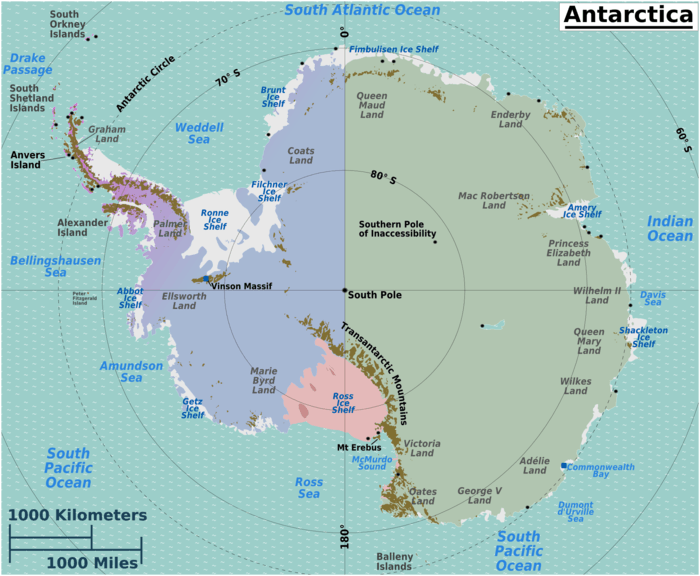
After the discovery of Antarctica, several teams had tried to sail to the South Pole or find a land route to the South Pole. None of the teams were successful. Ernest Shackleton tried to travel to the South Pole three times, but he was forced back on all of his expeditions before reaching the pole.
The first people to successfully reach the south pole were the four men of a party led by Roald Amundsen, who reached the pole on 14 December 1911. A competing British team led by Robert F. Scott reached the pole on 17 January 1912, but ran short of supplies and died of starvation or exposure 11 miles from their last supply depot. A U.S. Navy plane with two crew aboard flew over the pole on 29 November 1929.
No one stepped foot on the south pole again until 1956, when another U.S. Navy plane reached the pole, landing this time. Over the summer of 1956–'57, the U.S. constructed a station as part of the International Geophysical Year, which has been permanently staffed since. The first people to reach the pole overland (with limited air support) were Edmund Hillary and Vivian Fuchs, who arrived separately in January 1958. The opening of Patriot Hills — the first privately-supported logistics camp in Antarctica — in 1987 opened the way for people not on government-supported expeditions to access the South Pole. For summer 2010–'11, the company operating Patriot Hills moved to a new camp, Union Glacier Camp, which has a blue-ice (exceptionally solid) runway allowing large, wheeled cargo aircraft to arrive from South America and accommodates Twin Otter and Basler BT-67 ski-equipped planes to make the journey to the South Pole.
Climate
| South Pole | ||||||||||||||||||||||||||||||||||||||||||||||||||||||||||||
|---|---|---|---|---|---|---|---|---|---|---|---|---|---|---|---|---|---|---|---|---|---|---|---|---|---|---|---|---|---|---|---|---|---|---|---|---|---|---|---|---|---|---|---|---|---|---|---|---|---|---|---|---|---|---|---|---|---|---|---|---|
| Climate chart (explanation) | ||||||||||||||||||||||||||||||||||||||||||||||||||||||||||||
| ||||||||||||||||||||||||||||||||||||||||||||||||||||||||||||
| ||||||||||||||||||||||||||||||||||||||||||||||||||||||||||||
It's tempting to say that the climate at the South Pole is consistently bone-chilling cold, but it is actually not just bone-chilling cold. In December it is bone-chilling cold, with an average temperature of around −28 °C (−18 °F). However, in July it is astonishingly bone-chilling cold, with temperatures dropping to −80 °C (−112 °F). (Note that there are no "day-time highs" or "night-time lows" in these figures, because in the summer it is always day and in the winter it is always night at the South Pole.) Snowfall is scarce; since weather systems rarely penetrate into inland Antarctica and because the temperature is often too low, hence its desert status. The existing snow does drift, however, with winds averaging a modest 12 knots. (At these temperatures, calculating wind-chill factors is fairly pointless.) Antarctica is the coldest, windiest continent on Earth and as such an expedition there surely carries a risk of danger. Freak snowstorms and white conditions (both caused by high winds) can affect South Pole expeditions and have buried the ceremonial South Pole markers (they have to be bulldozed out of the snow usually).
Landscape
The terrain around the South Pole is consistently flat. Ice is fluid enough to settle to a flat surface if left undisturbed, and the underlying rock isn't geologically active, nor is there any rainfall to sculpt it.
Get in
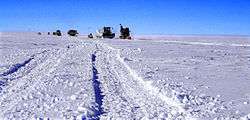
Antarctica is (for obvious reasons) the least-visited continent, and the South Pole is (because it is not accessible by sea) the least-visited site in Antarctica that is nominally "open to tourism". The South Pole is made accessible by the Jack F. Paulus Skiway, which is open from October to February each summer. As its name suggests, only ski-equipped aircraft can land here.
All expeditions take place in November through February, during the Antarctic summer/day, and when conditions are least hostile. They generally launch from Punta Arenas at the southern tip of Chile or Cape Town, South Africa, stopping at Union Glacier Camp in the Ellsworth Mountains on Antarctica. The South Pole is then reached as a day trip, with the exact timing of the trip calculated by weather conditions (and possibly chosen just hours before departing Union Glacier Camp). Some expeditions drop travelers well short of the Pole, leaving them to finish on the ice.
Union Glacier Camp is owned and operated by Antarctic Logistics and Expeditions (ALE), which has purchased Adventure Network International (ANI). Because logistical demands of reaching the South Pole necessitate a base/camp in Antarctica, ALE/ANI is the only company currently operating private flights to the South Pole (and just about anywhere else in interior Antarctica, for that matter). Other tour agencies offering journeys to the pole work with ANI, some simply marketing ANI trips as their own products, others combining their own Antarctic experience (like visits to Russian or French research stations or visits to penguin colonies) with a stay at Union Glacier Camp & South Pole, the latter of which are run by ANI.
Medical insurances and trip cancellation insurances are highly recommended or required for expeditions to the South Pole.
The times below are not exact, as air transportation in Antarctica is often delayed due to weather, and the time required for skiing to the South Pole depends on weather and rests.
- Antarctic Logistics and Expeditions (ALE). Offers flights several times a year combining a stay at their Union Glacier camp with a day trip to spend a few hours at the South Pole for a chilly USD $45,000 per person (summer 2013–'14). An overnight stay at the South Pole, combining two days at the South Pole with 4 days at Union Glacier run $48,500 (4–10 January 2014). Also offers guided treks by ski to the South Pole. Covering the full 1,170 km from coast to Pole involves an estimated 65 days of skiing, for about 7–9 hours a day, hauling a sled weighing 110–130 lbs (50–60 kg), and the price for the privilege is USD $64,000+ (summer 2013–'14). Alternatively, you can cheat and fly halfway there with the "Ski the Last Degree" package, in which case you'll ski for only about two weeks and pay a mere (comparatively) USD $53,450 (summer 2013–'14).
- Icetrek. Offers a week-long trip departing from Punta Arenas, Chile with one day at the Pole and 3–4 days at Union Glacier (USD $42,950; summer 2012–'13); a 13-day trip departing from Cape Town, South Africa with time spent at a coastal camp visiting penguins and a day trip to the Pole (€37,000; summer 2012–'13); a 13-day "ski the last degree" expedition (USD $55,900; summer 2012–'13); and a 51-day skiing expedition from coast to Pole (USD$56,950; summer 2012–'13).
- Northwest Passage. Offers a 48-day skiing expedition from coast to pole, a 15-day Ski the Last Degree package, a 10-day overnight stay at the South Pole for USD$55100 and a 9-day day trip to the South Pole for USD$51250.
- Polar-Quest. Offers 6/7 days trip by plane to Antarctica. You're flown in from Punta Arenas to Union Glacier and will make a day trip to the South Pole. USD $51250.
- White Desert. Offers flight expeditions to the South Pole. Flies from Cape Town, South Africa, to Whichaway Camp (Not Union Glacier Camp), and then to the South Pole for USD$92500.
The South Pole Traverse (or McMurdo – South Pole Highway) is a 1600 km "road" leading from McMurdo Station on the Ross Sea to the South Pole station. It is simply compacted snow with crevasses filled in and marked by flags. It can only be traveled by specialized tractors and sleds, which haul fuel and supplies to the South Pole each season.
Get around
The area of interest around the Pole is quite compact, making it easy to get from one part to another on foot. Venturing farther afield should be done on skis or using base transportation.
See
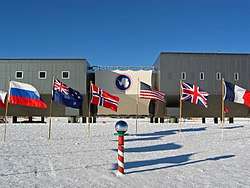
- There is a ceremonial south pole at the Amundsen-Scott South Pole Station, consisting of a metal sphere on a red and white pole, partially surrounded by the flags of the signatories of the Antarctic Treaty. Although great for photo opportunities, it is actually about 300 meters from the exact location of the South Pole.
- The geographic south pole is marked by a simpler rod with a head on it. The rod's head is made of brass and is designed and molded on-site. The ice on which the station sits shifts about 10 meters annually and the marker is moved on every New Year's Day in a small ceremony. There are also flags of the U.S. and Norway and a sign bearing quotes from the journals of Roald Amundsen and Robert F. Scott, leaders of the first two successful expeditions to the South Pole. (Scott's party arrived 34 days after Amundsen's, and died on the return trip.)
- There are three generations of structures at the site: The Old Pole, the original wooden station, built in 1956 and abandoned in 1975, now buried by drifting snow, off-limits for safety reasons. The metallic Geodesic Dome built in the early 1970s, 50 meters wide and 16 meters tall, enclosed several modular buildings, but was decommissioned in 2008 and completely disassembled in 2009–2010. The spot it formerly occupied is now pretty much indistinguishable after snow drifted in to cover it. The brown Elevated Station begun in 1999, a modular structure built on stilts to prevent snow from accumulating around it. Semicylindrical metal "arches" next to the dome serve as storage, power plant, and vehicle shop; they're connected to the main station via a 6-story unheated metal tower officially termed the "vertical tower" on the drawings, but is known around the station as the "beer can".
- A Visitor Center was erected on-site to cater for the few visitors the base receives. It was opened in response to pressure from visitors to be allowed into the official research building, which is technically forbidden. The center is no more than a small tent-like structure.
Do
- Ask for a tour of the station from staff.
- Circumnavigate the world in a few steps by walking around the geographic South Pole in a circle.
- Frisbee golf—"holes" are set up around the base to play frisbee golf... if you can handle the temperatures!
- Send a letter home at the world's southernmost post office in the Amundsen-Scott South Pole Station.
Buy
There is a small gift shop located within the station. Credit cards are not allowed in the gift shop.
Eat
While there is a base on site, visitors need to bring all their own food.
Drink
As the Pole is entirely covered by a massive ice sheet, those with the ability to melt ice should not worry about lack of water.
Sleep
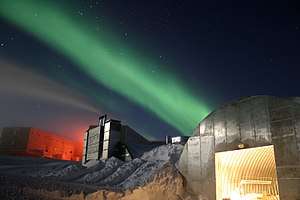
Although they are not in the habit of accommodating visitors, the facilities of Amundsen-Scott station can provide shelter in the event that weather prevents you from returning to your base at the end of your day visit. Visitors are expected to bring their own accommodation: basically, you will be camping in specialized extreme-cold tents and sleeping bags.
Stay healthy
All of the health and safety advisories for Antarctica generally apply to the Pole.
Although the ground at the South Pole is close to sea level, the thick ice at that location raises the station to an altitude of 9,300 feet (2,835 meters). And because the earth's rotation causes the atmosphere to thin out at the poles, the air pressure is more like at 11,000 feet (~3300 meters). So in addition to preparing for the coldness and dryness of the air, travel to the Pole also requires acclimatization for high-altitude travel. (See the Altitude sickness article for more.) The altitude also makes the danger of UV exposure even greater than at the Antarctic coast.
Go next
All visitors to the South Pole head north from there, as that is — literally — the only direction in which you can go. The nearest research station is the Chinese Kunlun Station and the nearest point of any interest is the Southern Pole of Inaccessibility.